Search Result
Results for "
DNA probe
" in MedChemExpress (MCE) Product Catalog:
1
Biochemical Assay Reagents
2
Isotope-Labeled Compounds
| Cat. No. |
Product Name |
Target |
Research Areas |
Chemical Structure |
-
- HY-139912
-
|
|
DNA Stain
|
Others
|
|
Biotin-aniline is a probe with substantially high reactivity towards RNA and DNA. Biotin-aniline emerges as more efficient probe for capturing subcellular transcriptome in living cells with high spatial specificity .
|
-
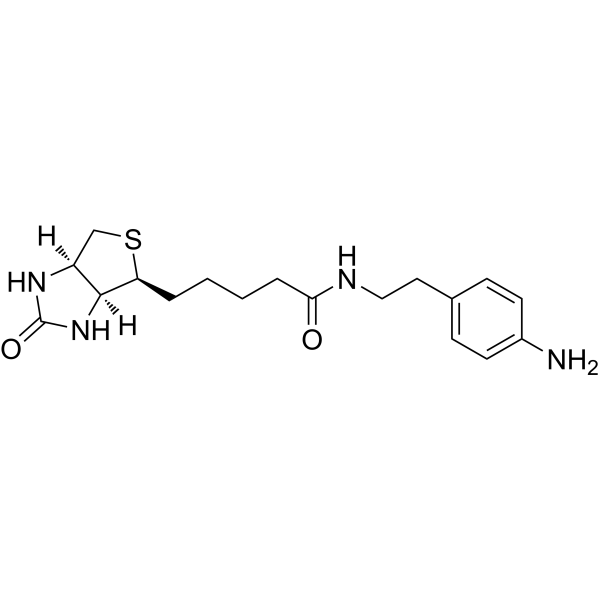
-
- HY-W103047
-
|
|
Fluorescent Dye
|
Others
|
|
1-Pyrenebutyric acid is a fluorescence probe that can be used in fluorescence determination of DNA. 1-Pyrenebutyric acid can be used as a linker for biomolecules to form a self-assembled monolayer on grapheme .
|
-
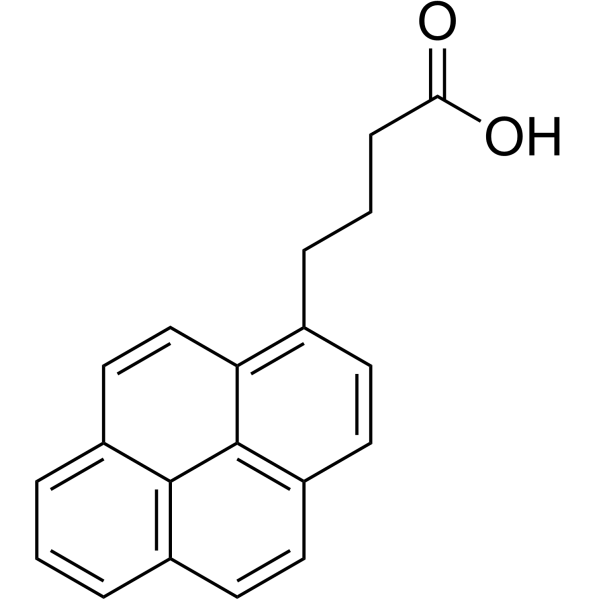
-
- HY-147652
-
|
|
DNA Stain
|
Others
|
|
G-quadruplex DNA fluorescence probe 1 (Compound E1) is a selective G-quadruplex DNA targeting fluorescent probe. G-quadruplex DNA fluorescence probe 1 can pass through membrane and enter living cells with low cytotoxicity .
|
-
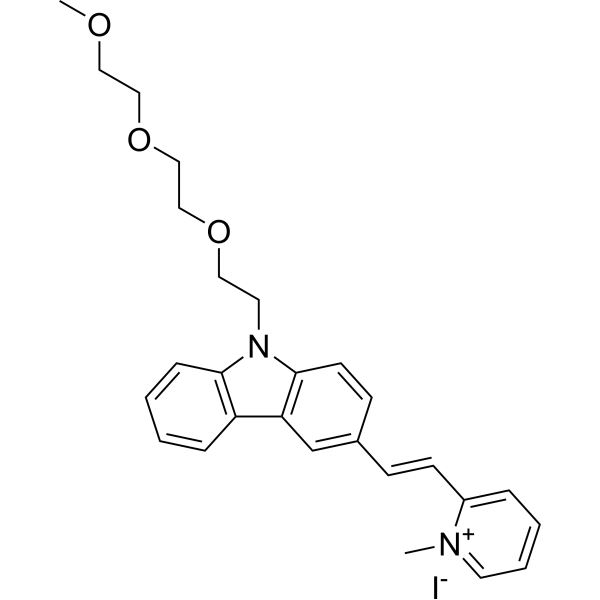
-
- HY-D1022
-
|
Biotin-16-deoxyuridine-5'-triphosphate
|
Fluorescent Dye
|
Others
|
|
Biotin-16-dUTP (Biotin-16-deoxyuridine-5'-triphosphate) can be used to replace its natural counterpart dTTP by enzymatically incorporating it into DNA/cDNA. Biotin-16- dUTP can be used to produce biotinylated DNA probes in a variety of assay applications .
|
-

-
- HY-D1022A
-
|
Biotin-16-deoxyuridine-5'-triphosphate trisodium
|
DNA Stain
|
Others
|
|
Biotin-16- dUTP (Biotin-16-deoxyuridine-5'-triphosphate) trisodium can be used to replace its natural counterpart dTTP by enzymatically incorporating it into DNA/cDNA. Biotin-16- dUTP trisodium can be used to produce biotinylated DNA probes in a variety of assay applications .
|
-

-
- HY-D1811
-
|
VF 555-dUTP
|
Fluorescent Dye
|
Others
|
|
Vari Fluor 555-dUTP (VF 555-dUTP) can be used to produce biotinylated DNA probes in a variety of assay applications by enzymatic incorporation into DNA/cDNA, replacing its natural counterpart, dTTP .
|
-

-
- HY-D1810
-
|
|
Fluorescent Dye
|
Others
|
|
Sulfo-Cy3-E-dUTP is enzymatically incorporated into DNA/cDNA as a substitute for its natural counterpart, dTTP. Sulfo-Cy3-E-dUTP can be used to produce biotinylated DNA probes for various detection applications .
|
-

-
- HY-D1812
-
|
VF 488-dUTP
|
Fluorescent Dye
|
Others
|
|
Vari Fluor 488-dUTP (VF 488-dUTP) can replace its natural counterpart, dTTP, by enzymatic incorporation into DNA/cDNA. Vari Fluor 555-dUTP can be used to produce biotinylated DNA probes in a variety of assay applications .
|
-

-
- HY-D1813
-
|
VF 594-dUTP
|
Fluorescent Dye
|
Others
|
|
Vari Fluor 594-dUTP (VF 594-dUTP) can replace its natural counterpart, dTTP, by enzymatic incorporation into DNA/cDNA. Vari Fluor 555-dUTP can be used to produce biotinylated DNA probes in a variety of assay applications .
|
-

-
- HY-D1814
-
|
VF 640-dUTP
|
Fluorescent Dye
|
Others
|
|
Vari Fluor 640-dUTP (VF 640-dUTP) is enzymatically incorporated into DNA/cDNA and can replace its natural counterpart, dTTP. Vari Fluor 555-dUTP can be used to produce biotinylated DNA probes in a variety of assay applications .
|
-

-
- HY-D2207
-
|
|
Fluorescent Dye
|
Others
|
|
SiR700-CH2F, a near infrared silica-containing Rhodamine fluorophore, is a highly specific DNA probe (EX/Em= 680/702 nm) .
|
-
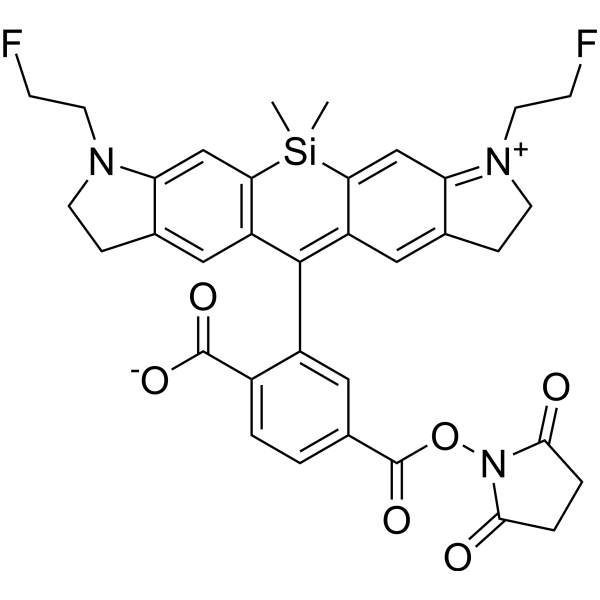
-
- HY-W012642A
-
|
|
DNA Stain
|
Others
|
|
2-Aminopurine dihydrochloride is a fluorescent analog of guanosine. 2-Aminopurine dihydrochloride can be used as a fluorescence probe for nucleic acid structure and dynamics. Incorporating 2-Aminopurine dihydrochloride into DNA quenches its fluorescence .
|
-
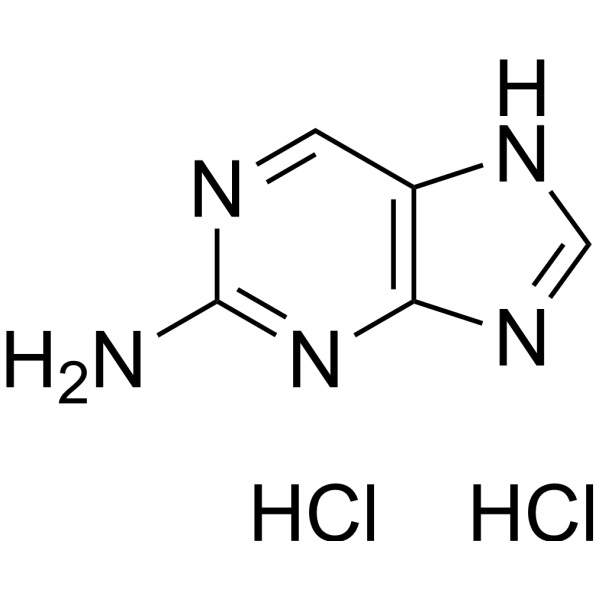
-
- HY-D2267
-
|
|
Fluorescent Dye
|
Others
|
|
JF646-Hoechst is a fluorescent red DNA probe that is an ideal substitute for large oligonucleotide-coupled antibodies used in PAINT experiments, especially for bacterial studies. JF646-Hoechst excitation/emission maximum =655/670 nm .
|
-
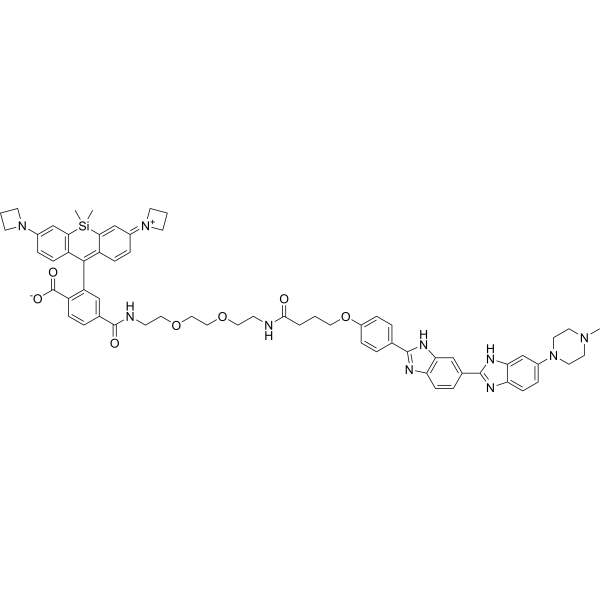
-
- HY-D1725
-
|
|
DNA Stain
|
Cancer
|
|
Cy3-dCTP is a DNA probe directly labeled by fluorescently labeled nucleotide. Cy3-dCTP also is cyanine-dye-labeled nucleotide triphosphate. Cy3-dCTP can be used for the research of imaging . Cy3-dCTP is a click chemistry reagent, it contains an Alkyne group and can undergo copper-catalyzed azide-alkyne cycloaddition (CuAAc) with molecules containing Azide groups.
|
-
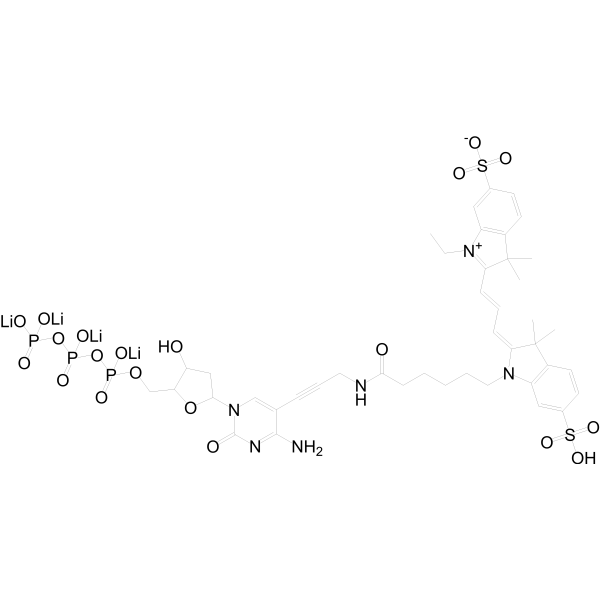
-
- HY-148161
-
|
|
DNA/RNA Synthesis
|
Cancer
|
|
L82-G17 is an uncompetitive DNA ligase I (Lig I)-selective inhibitor. L82-G17 inhibits the third step of the ligation reaction, phosphodiester bond formation. L82-G17can be used as a probe of the catalytic activity .
|
-
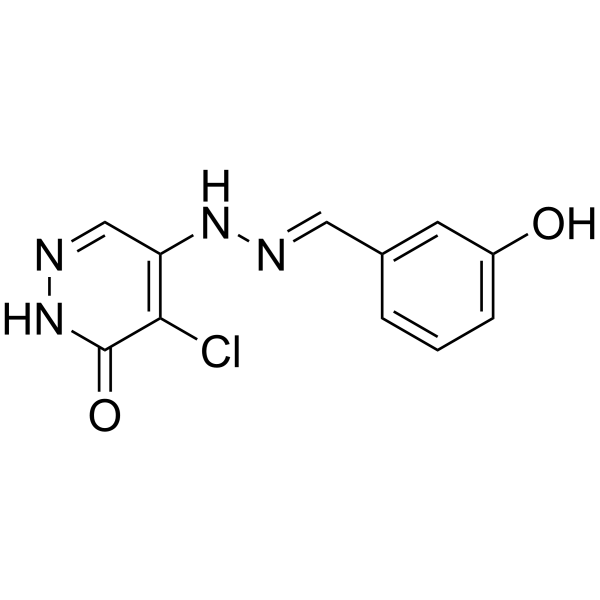
-
- HY-113352
-
|
|
Endogenous Metabolite
|
Others
|
|
7-Methylguanine is a metabolite of DNA methylation. It can be generated by methylating agents, and used as a probe of protein–DNA interactions and a key component of DNA sequencing method.
|
-
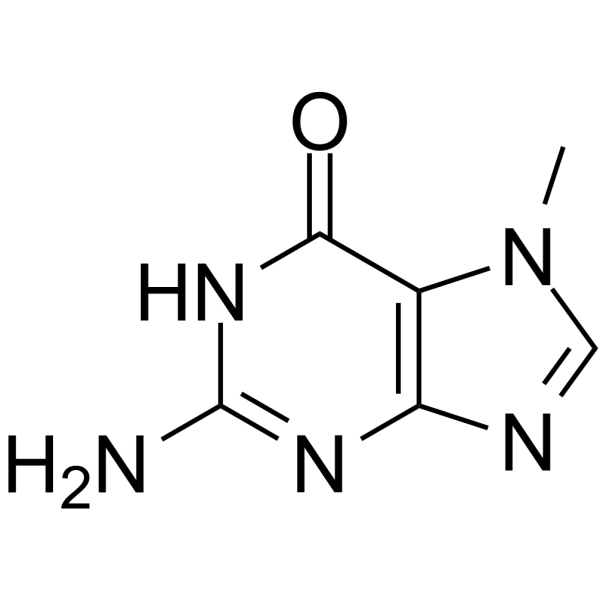
-
- HY-135136
-
-
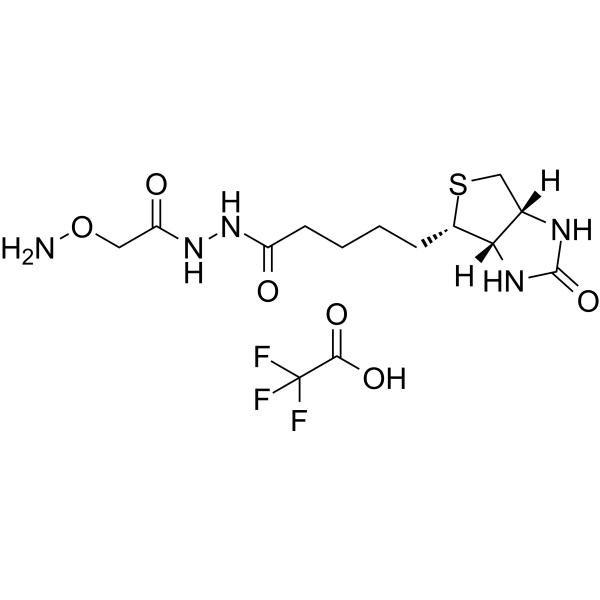
-
- HY-157916
-
|
Aldehyde reactive probe
|
Fluorescent Dye
|
Others
|
|
ARP (Aldehyde reactive probe) is an aldehyde reactive probe for detecting abasic site (common DNA lesions and intermediates in mutagenesis and carcinogenesis) in DNA, which specificially tags AP site with biotin residues. ARP is highly sensitive with a femtomolar-level basic site detection capabilities (less than one site per 10 4 nucleotides) .
|
-

-
- HY-113352S
-
|
|
Endogenous Metabolite
|
Others
|
|
7-Methylguanine-d3 is the deuterium labeled 7-Methylguanine[1]. 7-Methylguanine is a metabolite of DNA methylation. It can be generated by methylating agents, and used as a probe of protein–DNA interactions and a key component of DNA sequencing method[2].
|
-
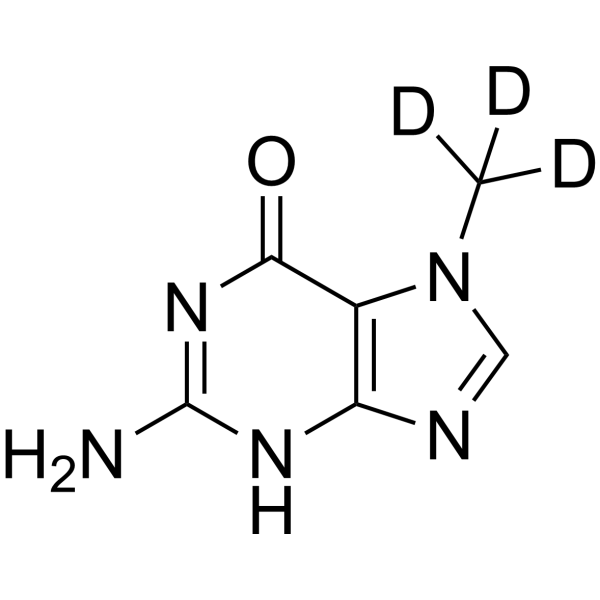
-
- HY-157322
-
|
|
Others
|
Infection
|
|
SAV13 is an inhibitor of SaeR. SAV13 is an analogue of HR3744. SAV13 inhibits SaeR-DNA probe binding and has antivirulence properties .
|
-

-
- HY-118581
-
|
|
Topoisomerase
|
Cancer
|
|
Coralyne chloride is a protoberberine alkaloid with potent anti-cancer activities. Coralyne chloride acts as a potent topoisomerase I poison and induces Top I mediated DNA cleavage . Coralyne chloride can be used for preparing coralyne derivatives as DNA binding fluorescent probes .
|
-
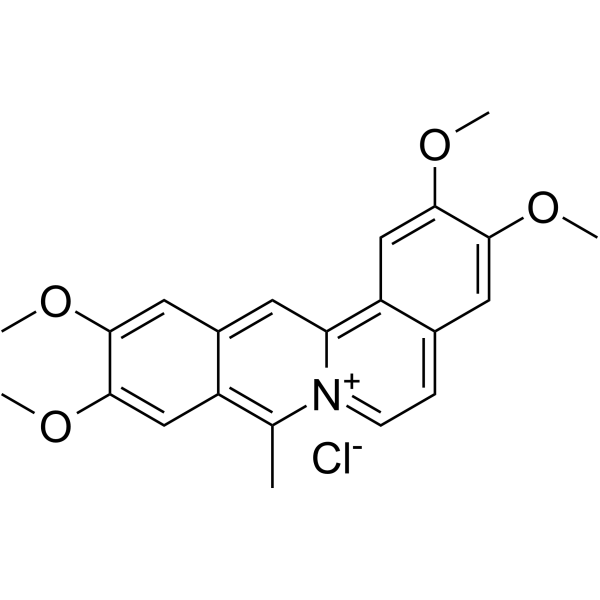
-
- HY-W012642
-
|
|
DNA Stain
|
Others
|
|
2-Aminopurine, a fluorescent analog of guanosine and adenosine, is a widely used fluorescence-decay-based probe of DNA structure. When 2-Aminopurine is inserted in anoligonucleotide, its fluorescence is highly quenched by stacking with the natural bases. 2-Aminopurine has been used to probe nucleic acid structure and dynamics .
|
-

-
- HY-135009
-
|
DASPI
|
G-quadruplex
|
Others
|
|
2-Di-1-ASP (DASPI; Compound 18a) is a mono-stryryl dye, and widely used as mitochondrial stain and groove-binding fluorescent probes for double-stranded DNA. 2-Di-1-ASP is selective for G-quadruplex (G4) and double-stranded DNA .
|
-
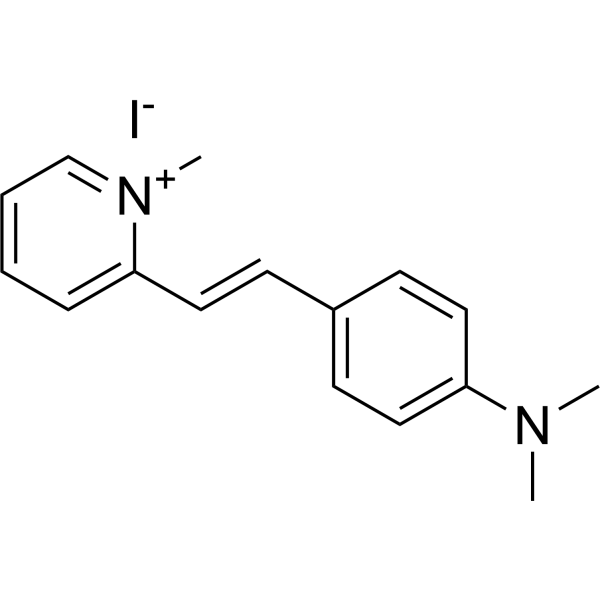
-
- HY-D2220
-
|
|
DNA Stain
|
Others
|
|
SiR-Hoechst is a far-red fluorescent DNA probe being used widely for time-lapse imaging of living cells. SiR-Hoechst is minimally toxic at concentrations as high as 10-25 µM. SiR-Hoechst induces DNA damage responses and G2 arrest at concentrations well below 1 µM .
|
-
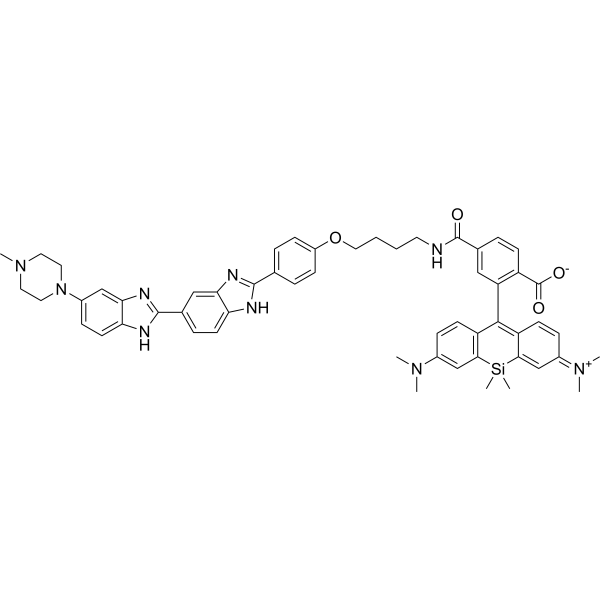
-
- HY-D0150
-
|
|
Fluorescent Dye
|
Others
|
|
Thiazole Orange is an asymmetric anthocyanin dye that can be coupled with oligonucleotides (ONs) to prepare fluorescent hybridization probes. Thiazole Orange can be used for reticulocyte analysis. λEx/λEm (including DNA) of Thiazole Orange =510/527 nm .
|
-
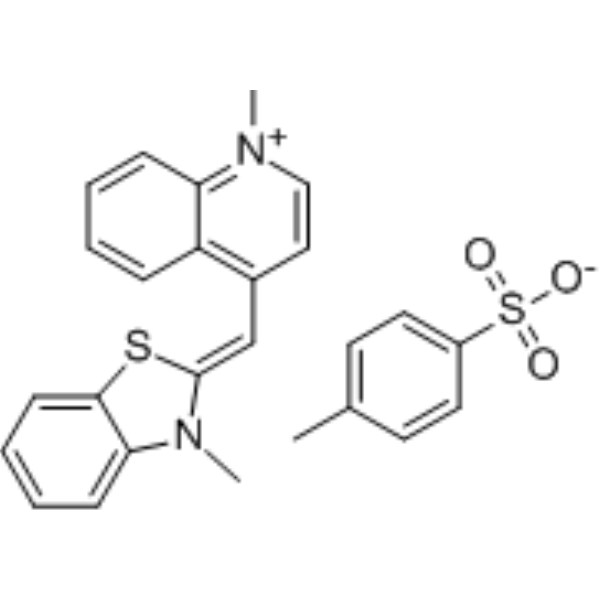
-
- HY-151662
-
|
N3-TFBA
|
ADC Linker
|
Others
|
|
4-Azido-2,3,5,6-tetrafluorobenzoic Acid (N3-TFBA) is a click chemistry reagent containing an azide group. 4-Azido-2,3,5,6-tetrafluorobenzoic Acid is a complex with FAM-labeled DNA probe. 4-Azido-2,3,5,6-tetrafluorobenzoic Acid can be used as versatile photoaffinity labeling agents to probe biological receptors.
|
-

-
- HY-122198
-
|
|
Others
|
Cancer
|
|
ML367 is a potent inhibitor of ATPase family AAA domain-containing protein 5 (ATAD5) stabilization, acts as a probe molecule that has low micromolar inhibitory activity. ML367 blocks DNA repair pathways, suppresses general DNA damage responses including RPA32-phosphorylation and CHK1-phosphorylation in response to UV irradiation .
|
-

-
- HY-D1742
-
|
|
Fluorescent Dye
DNA Stain
|
Others
|
|
DRAQ5 is a novel cell permeant and far red-fluorescing DNA probe. DRAQ5 excites at a wavelength of 647 nm, close to the Ex, and produces a fluorescence spectrum extending from 665 nm out to beyond 780 nm wavelengths. DRAQ5 fluorescence reflects cellular DNA content. DRAQ5 can be used in combination with FITC and RPE-labelled antibodies, without the need for fluorescence compensation .
|
-

-
- HY-133821
-
|
|
G-quadruplex
|
Neurological Disease
|
|
N-Methylmesoporphyrin IX (NMM), a widely used G-quadruplex DNA specific fluorescent binder, is an efficient probe for monitoring Aβ fibrillation. N-Methylmesoporphyrin IX is an in situ inhibitor and an ex situ monitor for Aβ amyloidogenesis both in vitro and in cells. N-Methylmesoporphyrin IX is sensitive to G-quadruplexes DNA but has no response to duplexes, triplexes and single-stranded forms DNA. N-Methylmesoporphyrin IX is nonfluorescent alone or in monomeric Aβ environments, but emits strong fluorescence through stacking with the Aβ assemblies .
|
-
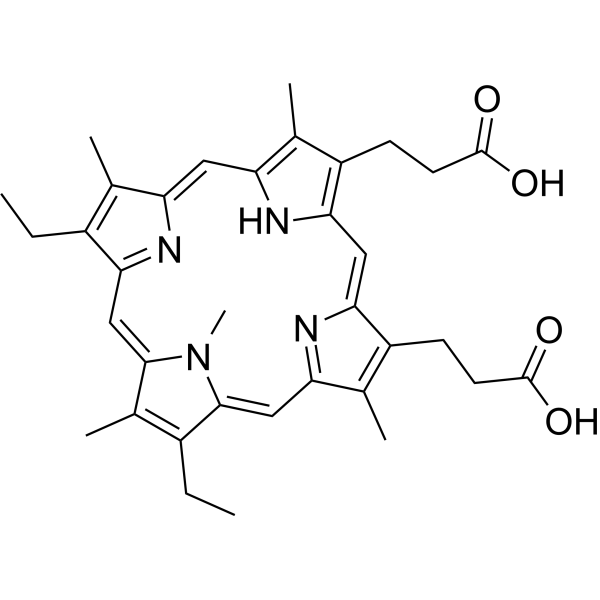
-
- HY-114346A
-
|
|
Fluorescent Dye
|
Others
|
|
ODIPY FL EDA free base is an amine-based, green fluorescent probe. The R-NH2 of ODIPY FL EDA free base can be coupled with aldehydes or ketones to form reversible Schiff base products. Convert to stable amine derivatives using reducing agents such as sodium borohydride or sodium cyanoborohydride. ODIPY FL EDA free base can be used to detect modified or normal deoxynucleotides and demonstrate DNA damage and genomic DNA methylation.
|
-
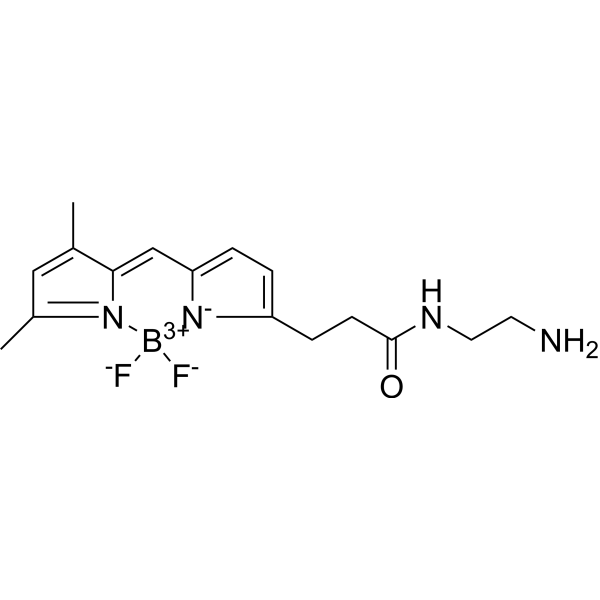
-
- HY-135846
-
-

-
- HY-D1818
-
|
|
Fluorescent Dye
|
Others
|
|
Vari Fluor 680-Phalloidin is a fluorescent derivative of Phalloidin that specifically labels myofilament proteins and exhibits red fluorescence when labeled at 680/700 nm .
|
-

-
- HY-D1819
-
|
|
Fluorescent Dye
|
Others
|
|
Vari Fluor 633-Phalloidin is a fluorescent derivative of Phalloidin that specifically labels myofilament proteins and exhibits red fluorescence at 630/650 nm when labeled .
|
-

-
- HY-D1820
-
|
|
Fluorescent Dye
|
Others
|
|
Vari Fluor 594-Phalloidin is a fluorescent derivative of Phalloidin that specifically labels myofilament proteins and exhibits red fluorescence at 585/609 nm when labeled .
|
-

-
- HY-D1816
-
|
|
Fluorescent Dye
|
Others
|
|
Vari Fluor 555-Phalloidin is a fluorescent derivative of Phalloidin that specifically labels myofilament proteins and exhibits red fluorescence when labeled, allowing for fluorescence imaging using the PE channel (Ex/Em=550 nm/561 nm) .
|
-

-
- HY-D1817
-
|
|
Fluorescent Dye
|
Others
|
|
Vari Fluor 488-Phalloidin is a fluorescent derivative of Phalloidin that specifically labels myofilament proteins and exhibits green fluorescence when labeled, allowing for fluorescence imaging using FITC channels (Ex/Em=488 nm/513 nm) .
|
-

-
- HY-D1883
-
|
|
Fluorescent Dye
|
Others
|
|
Cy7.5-COOH (compound 8f), a cyanine dye, is a highly fluorescent compound (Abs/Em = 781/808 nm). Cy7.5-COOH can be used as a fluorescent probe in a wide-range of applications such as DNA sequencing, flow cytometry and in vivo imaging .
|
-

-
- HY-D2222
-
|
|
Fluorescent Dye
|
Others
|
|
5-HMSiR-Hoechst is a DNA probe. 5-HMSiR-Hoechst comprises Hoechst 33258 and spontaneously blinking far-red hydroxymethyl silicon-rhodamine (HMSiR). 5-HMSiR-Hoechst can stain living cells. Ex/Em=640 nm/675 nm .
|
-
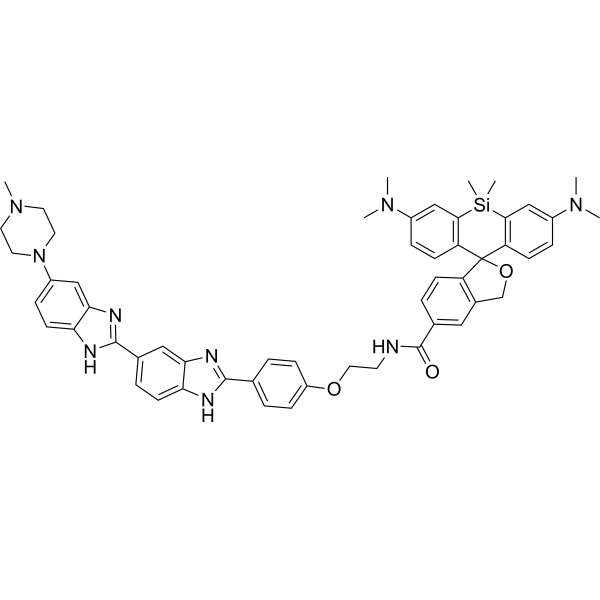
-
- HY-D0215
-
|
Safranine T
|
Fluorescent Dye
|
Others
|
|
Safranin (Safranin T) is an important and classical phenazinium dye. Safranin has been extensively used in the academic field as a spectroscopic probe and indicator. Safranin possesses a planar structure and cationic charge. It can readily intercalate into biological macromolecules, including DNA and proteins. Safranin can be used as a redox indicator in the determination of metal ion concentration .
|
-
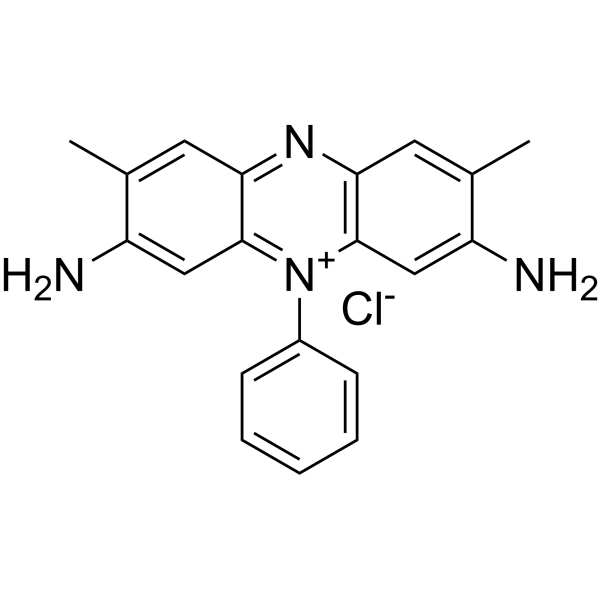
-
- HY-43520
-
|
|
Fluorescent Dye
|
Others
|
|
BODIPY-FL is a potent fluorescent dye. BODIPY-FL can be used to label probe or primer for fluorescent quenching-based quantitative detection of specific DNA/RNA.BODIPY-FL-labeled monoterpenoid can be used to examine the features of a broad spectrum of Gram-positive and Gram-negative bacteria and pathogenic fungi as well .
|
-

-
- HY-D1883A
-
|
|
Fluorescent Dye
|
Others
|
|
Cy7.5-COOH TEA (compound 8f), a cyanine dye, is a highly fluorescent compound (Abs/Em = 781/808 nm). Cy7.5-COOH TEA can be used as a fluorescent probe in a wide-range of applications such as DNA sequencing, flow cytometry and in vivo imaging .
|
-

-
- HY-160063
-
|
|
Others
|
Cancer
|
|
SW1 aptamer sodium is a high-affinity DNA aptamer (Kd: 123.62 nM) that targets liver cancer SMMC-7721 cells and targets intracellular components within the nucleus. SW1 aptamer sodium can also identify various other types of cancer cells and tissues, serving as an effective molecular probe for clinical cancer diagnosis .
|
-
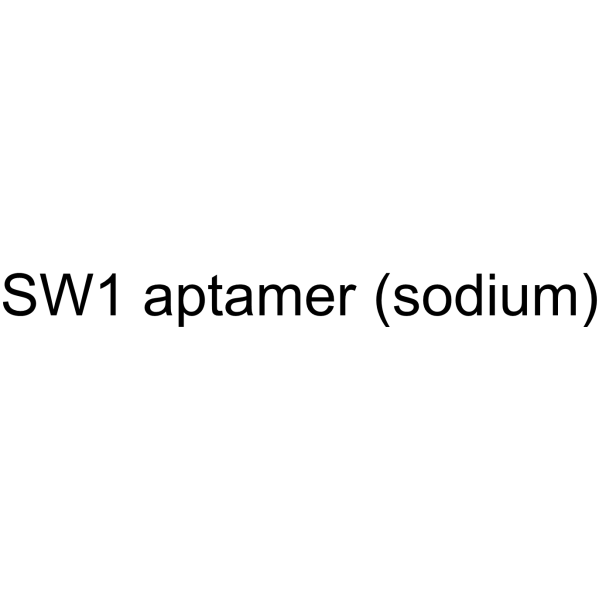
-
- HY-D1730A
-
|
|
Fluorescent Dye
|
Others
|
|
AF488 NHS ester TEA is an analog of AF488 NHS ester. AF488 NHS ester TEA is used in DNA sequencing research .
|
-

-
- HY-161296
-
|
|
Bacterial
HIV
|
Infection
|
|
TH6342 is a SAMHD1 modulator that binds to pretetrameric SAMHD1 and prevents its oligomerization and allosteric activation. SAMHD1 is a dNTP triphosphohydrolase and an HIV-1 restriction factor. SAMHD1 can limit the replication of retroviruses and DNA viruses and has antiviral effects. The inhibitory mechanism of TH6342 does not occupy the SAMHD1 nucleotide-binding pocket, gently binds the target, and functions as a chemical probe .
|
-
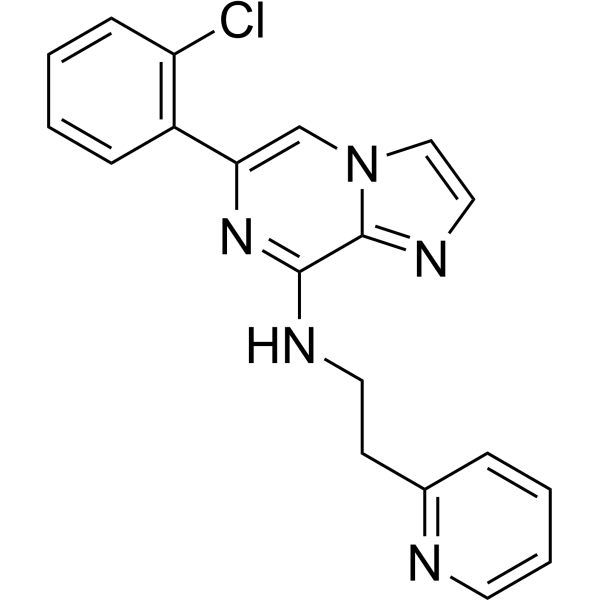
-
- HY-W010706
-
|
5'-O-DMT-N4-Bz-dC
|
Nucleoside Antimetabolite/Analog
|
Others
|
|
N4-Benzoyl-5'-O-(4,4'-dimethoxytrityl)-2'-deoxycytidine (5'-O-DMT-N4-Bz-dC) can be used for synthesis oligodeoxynucleotides containing a 3'-S-phosphorothiolate (3'-PS) linkage. N4-Benzoyl-5'-O-(4,4'-dimethoxytrityl)-2'-deoxycytidine is an useful tool for probing enzyme-catalyzed cleavage processes in DNA .
|
-
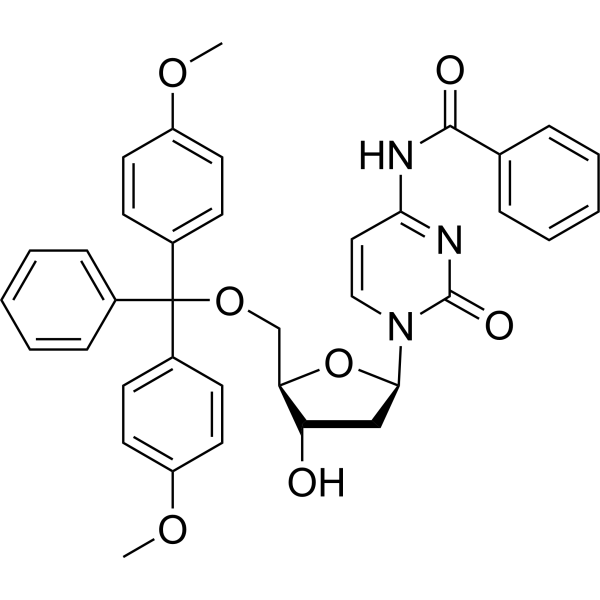
-
- HY-B1422
-
|
Aminacrine
|
Bacterial
HIV
|
Infection
|
|
9-Aminoacridine, a fluorescent probe, acts as an indicator of pH for quantitative determination of transmembrane pH gradients (inside acidic). 9-Aminoacridine is an antimicrobial. 9-Aminoacridine exerts its antimicrobial activity by interacting with specific bacterial DNA and disrupting the proton motive force in K. pneumoniae. 9-Aminoacridine is a HIV-1 inhibitor and inhibits HIV LTR transcription highly dependent on the presence and location of the amino moiety. 9-Aminoacridine inhibits virus replication in HIV-1 infected cell lines. 9-Aminoacridine is used as a Rifampin (RIF; HY-B0272) adjuvant for the multidrug-resistant K. pneumoniae infections .
|
-
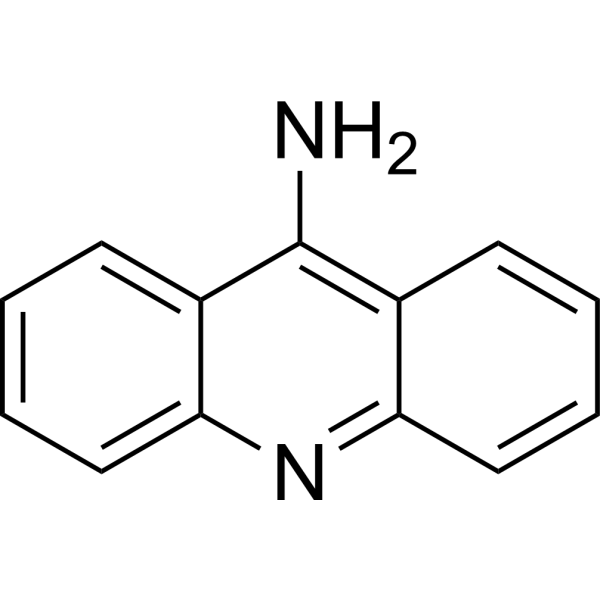
-
- HY-B1422S
-
|
Aminacrine-13C6
|
Bacterial
HIV
Isotope-Labeled Compounds
|
Infection
|
|
9-Aminoacridine-13C6 is the 13C-labeled 9-Aminoacridine(HY-B1422). 9-Aminoacridine, a fluorescent probe, acts as an indicator of pH for quantitative determination of transmembrane pH gradients (inside acidic). 9-Aminoacridine is an antimicrobial. 9-Aminoacridine exerts its antimicrobial activity by interacting with specific bacterial DNA and disrupting the proton motive force in K. pneumoniae. 9-Aminoacridine is a HIV-1 inhibitor and inhibits HIV LTR transcription highly dependent on the presence and location of the amino moiety. 9-Aminoacridine inhibits virus replication in HIV-1 infected cell lines. 9-Aminoacridine is used as a Rifampin (RIF; HY-B0272) adjuvant for the multidrug-resistant K. pneumoniae infections .
|
-

| Cat. No. |
Product Name |
Type |
-
- HY-W103047
-
|
|
Fluorescent Dyes/Probes
|
|
1-Pyrenebutyric acid is a fluorescence probe that can be used in fluorescence determination of DNA. 1-Pyrenebutyric acid can be used as a linker for biomolecules to form a self-assembled monolayer on grapheme .
|
-
- HY-D1022
-
|
Biotin-16-deoxyuridine-5'-triphosphate
|
Fluorescent Dyes/Probes
|
|
Biotin-16-dUTP (Biotin-16-deoxyuridine-5'-triphosphate) can be used to replace its natural counterpart dTTP by enzymatically incorporating it into DNA/cDNA. Biotin-16- dUTP can be used to produce biotinylated DNA probes in a variety of assay applications .
|
-
- HY-D1022A
-
|
Biotin-16-deoxyuridine-5'-triphosphate trisodium
|
Fluorescent Dyes/Probes
|
|
Biotin-16- dUTP (Biotin-16-deoxyuridine-5'-triphosphate) trisodium can be used to replace its natural counterpart dTTP by enzymatically incorporating it into DNA/cDNA. Biotin-16- dUTP trisodium can be used to produce biotinylated DNA probes in a variety of assay applications .
|
-
- HY-D1811
-
|
VF 555-dUTP
|
Dyes
|
|
Vari Fluor 555-dUTP (VF 555-dUTP) can be used to produce biotinylated DNA probes in a variety of assay applications by enzymatic incorporation into DNA/cDNA, replacing its natural counterpart, dTTP .
|
-
- HY-D1810
-
|
|
Dyes
|
|
Sulfo-Cy3-E-dUTP is enzymatically incorporated into DNA/cDNA as a substitute for its natural counterpart, dTTP. Sulfo-Cy3-E-dUTP can be used to produce biotinylated DNA probes for various detection applications .
|
-
- HY-D1812
-
|
VF 488-dUTP
|
Dyes
|
|
Vari Fluor 488-dUTP (VF 488-dUTP) can replace its natural counterpart, dTTP, by enzymatic incorporation into DNA/cDNA. Vari Fluor 555-dUTP can be used to produce biotinylated DNA probes in a variety of assay applications .
|
-
- HY-D1813
-
|
VF 594-dUTP
|
Dyes
|
|
Vari Fluor 594-dUTP (VF 594-dUTP) can replace its natural counterpart, dTTP, by enzymatic incorporation into DNA/cDNA. Vari Fluor 555-dUTP can be used to produce biotinylated DNA probes in a variety of assay applications .
|
-
- HY-D1814
-
|
VF 640-dUTP
|
Dyes
|
|
Vari Fluor 640-dUTP (VF 640-dUTP) is enzymatically incorporated into DNA/cDNA and can replace its natural counterpart, dTTP. Vari Fluor 555-dUTP can be used to produce biotinylated DNA probes in a variety of assay applications .
|
-
- HY-D2207
-
|
|
Fluorescent Dyes/Probes
|
|
SiR700-CH2F, a near infrared silica-containing Rhodamine fluorophore, is a highly specific DNA probe (EX/Em= 680/702 nm) .
|
-
- HY-W012642A
-
|
|
Fluorescent Dyes/Probes
|
|
2-Aminopurine dihydrochloride is a fluorescent analog of guanosine. 2-Aminopurine dihydrochloride can be used as a fluorescence probe for nucleic acid structure and dynamics. Incorporating 2-Aminopurine dihydrochloride into DNA quenches its fluorescence .
|
-
- HY-D2267
-
|
|
Fluorescent Dyes/Probes
|
|
JF646-Hoechst is a fluorescent red DNA probe that is an ideal substitute for large oligonucleotide-coupled antibodies used in PAINT experiments, especially for bacterial studies. JF646-Hoechst excitation/emission maximum =655/670 nm .
|
-
- HY-W012642
-
|
|
Fluorescent Dyes/Probes
|
|
2-Aminopurine, a fluorescent analog of guanosine and adenosine, is a widely used fluorescence-decay-based probe of DNA structure. When 2-Aminopurine is inserted in anoligonucleotide, its fluorescence is highly quenched by stacking with the natural bases. 2-Aminopurine has been used to probe nucleic acid structure and dynamics .
|
-
- HY-135009
-
|
DASPI
|
Fluorescent Dyes/Probes
|
|
2-Di-1-ASP (DASPI; Compound 18a) is a mono-stryryl dye, and widely used as mitochondrial stain and groove-binding fluorescent probes for double-stranded DNA. 2-Di-1-ASP is selective for G-quadruplex (G4) and double-stranded DNA .
|
-
- HY-D2220
-
|
|
Fluorescent Dyes/Probes
|
|
SiR-Hoechst is a far-red fluorescent DNA probe being used widely for time-lapse imaging of living cells. SiR-Hoechst is minimally toxic at concentrations as high as 10-25 µM. SiR-Hoechst induces DNA damage responses and G2 arrest at concentrations well below 1 µM .
|
-
- HY-D0150
-
|
|
Fluorescent Dyes/Probes
|
|
Thiazole Orange is an asymmetric anthocyanin dye that can be coupled with oligonucleotides (ONs) to prepare fluorescent hybridization probes. Thiazole Orange can be used for reticulocyte analysis. λEx/λEm (including DNA) of Thiazole Orange =510/527 nm .
|
-
- HY-151662
-
|
N3-TFBA
|
Fluorescent Dyes/Probes
|
|
4-Azido-2,3,5,6-tetrafluorobenzoic Acid (N3-TFBA) is a click chemistry reagent containing an azide group. 4-Azido-2,3,5,6-tetrafluorobenzoic Acid is a complex with FAM-labeled DNA probe. 4-Azido-2,3,5,6-tetrafluorobenzoic Acid can be used as versatile photoaffinity labeling agents to probe biological receptors.
|
-
- HY-D1742
-
|
|
Fluorescent Dyes/Probes
|
|
DRAQ5 is a novel cell permeant and far red-fluorescing DNA probe. DRAQ5 excites at a wavelength of 647 nm, close to the Ex, and produces a fluorescence spectrum extending from 665 nm out to beyond 780 nm wavelengths. DRAQ5 fluorescence reflects cellular DNA content. DRAQ5 can be used in combination with FITC and RPE-labelled antibodies, without the need for fluorescence compensation .
|
-
- HY-133821
-
|
|
Fluorescent Dyes/Probes
|
|
N-Methylmesoporphyrin IX (NMM), a widely used G-quadruplex DNA specific fluorescent binder, is an efficient probe for monitoring Aβ fibrillation. N-Methylmesoporphyrin IX is an in situ inhibitor and an ex situ monitor for Aβ amyloidogenesis both in vitro and in cells. N-Methylmesoporphyrin IX is sensitive to G-quadruplexes DNA but has no response to duplexes, triplexes and single-stranded forms DNA. N-Methylmesoporphyrin IX is nonfluorescent alone or in monomeric Aβ environments, but emits strong fluorescence through stacking with the Aβ assemblies .
|
-
- HY-114346A
-
|
|
Dyes
|
|
ODIPY FL EDA free base is an amine-based, green fluorescent probe. The R-NH2 of ODIPY FL EDA free base can be coupled with aldehydes or ketones to form reversible Schiff base products. Convert to stable amine derivatives using reducing agents such as sodium borohydride or sodium cyanoborohydride. ODIPY FL EDA free base can be used to detect modified or normal deoxynucleotides and demonstrate DNA damage and genomic DNA methylation.
|
-
- HY-D1818
-
|
|
Dyes
|
|
Vari Fluor 680-Phalloidin is a fluorescent derivative of Phalloidin that specifically labels myofilament proteins and exhibits red fluorescence when labeled at 680/700 nm .
|
-
- HY-D1819
-
|
|
Dyes
|
|
Vari Fluor 633-Phalloidin is a fluorescent derivative of Phalloidin that specifically labels myofilament proteins and exhibits red fluorescence at 630/650 nm when labeled .
|
-
- HY-D1820
-
|
|
Dyes
|
|
Vari Fluor 594-Phalloidin is a fluorescent derivative of Phalloidin that specifically labels myofilament proteins and exhibits red fluorescence at 585/609 nm when labeled .
|
-
- HY-D1816
-
|
|
Dyes
|
|
Vari Fluor 555-Phalloidin is a fluorescent derivative of Phalloidin that specifically labels myofilament proteins and exhibits red fluorescence when labeled, allowing for fluorescence imaging using the PE channel (Ex/Em=550 nm/561 nm) .
|
-
- HY-D1817
-
|
|
Dyes
|
|
Vari Fluor 488-Phalloidin is a fluorescent derivative of Phalloidin that specifically labels myofilament proteins and exhibits green fluorescence when labeled, allowing for fluorescence imaging using FITC channels (Ex/Em=488 nm/513 nm) .
|
-
- HY-D1883
-
|
|
Fluorescent Dyes/Probes
|
|
Cy7.5-COOH (compound 8f), a cyanine dye, is a highly fluorescent compound (Abs/Em = 781/808 nm). Cy7.5-COOH can be used as a fluorescent probe in a wide-range of applications such as DNA sequencing, flow cytometry and in vivo imaging .
|
-
- HY-D2222
-
|
|
Fluorescent Dyes/Probes
|
|
5-HMSiR-Hoechst is a DNA probe. 5-HMSiR-Hoechst comprises Hoechst 33258 and spontaneously blinking far-red hydroxymethyl silicon-rhodamine (HMSiR). 5-HMSiR-Hoechst can stain living cells. Ex/Em=640 nm/675 nm .
|
-
- HY-D0215
-
|
Safranine T
|
Dyes
|
|
Safranin (Safranin T) is an important and classical phenazinium dye. Safranin has been extensively used in the academic field as a spectroscopic probe and indicator. Safranin possesses a planar structure and cationic charge. It can readily intercalate into biological macromolecules, including DNA and proteins. Safranin can be used as a redox indicator in the determination of metal ion concentration .
|
-
- HY-43520
-
|
|
Fluorescent Dyes/Probes
|
|
BODIPY-FL is a potent fluorescent dye. BODIPY-FL can be used to label probe or primer for fluorescent quenching-based quantitative detection of specific DNA/RNA.BODIPY-FL-labeled monoterpenoid can be used to examine the features of a broad spectrum of Gram-positive and Gram-negative bacteria and pathogenic fungi as well .
|
-
- HY-D1883A
-
|
|
Fluorescent Dyes/Probes
|
|
Cy7.5-COOH TEA (compound 8f), a cyanine dye, is a highly fluorescent compound (Abs/Em = 781/808 nm). Cy7.5-COOH TEA can be used as a fluorescent probe in a wide-range of applications such as DNA sequencing, flow cytometry and in vivo imaging .
|
-
- HY-D1730A
-
|
|
Fluorescent Dyes/Probes
|
|
AF488 NHS ester TEA is an analog of AF488 NHS ester. AF488 NHS ester TEA is used in DNA sequencing research .
|
-
- HY-B1422
-
|
Aminacrine
|
Fluorescent Dyes/Probes
|
|
9-Aminoacridine, a fluorescent probe, acts as an indicator of pH for quantitative determination of transmembrane pH gradients (inside acidic). 9-Aminoacridine is an antimicrobial. 9-Aminoacridine exerts its antimicrobial activity by interacting with specific bacterial DNA and disrupting the proton motive force in K. pneumoniae. 9-Aminoacridine is a HIV-1 inhibitor and inhibits HIV LTR transcription highly dependent on the presence and location of the amino moiety. 9-Aminoacridine inhibits virus replication in HIV-1 infected cell lines. 9-Aminoacridine is used as a Rifampin (RIF; HY-B0272) adjuvant for the multidrug-resistant K. pneumoniae infections .
|
| Cat. No. |
Product Name |
Type |
-
- HY-157916
-
|
Aldehyde reactive probe
|
Biochemical Assay Reagents
|
|
ARP (Aldehyde reactive probe) is an aldehyde reactive probe for detecting abasic site (common DNA lesions and intermediates in mutagenesis and carcinogenesis) in DNA, which specificially tags AP site with biotin residues. ARP is highly sensitive with a femtomolar-level basic site detection capabilities (less than one site per 10 4 nucleotides) .
|
| Cat. No. |
Product Name |
Target |
Research Area |
-
- HY-P4479
-
|
|
Peptides
|
Others
|
|
H-Phe-Phe-Phe-OH is an aromatic tripeptide that has the potential to be used as DNA molecular probe .
|
| Cat. No. |
Product Name |
Category |
Target |
Chemical Structure |
| Cat. No. |
Product Name |
Chemical Structure |
-
- HY-113352S
-
|
|
|
7-Methylguanine-d3 is the deuterium labeled 7-Methylguanine[1]. 7-Methylguanine is a metabolite of DNA methylation. It can be generated by methylating agents, and used as a probe of protein–DNA interactions and a key component of DNA sequencing method[2].
|
-

-
- HY-B1422S
-
|
|
|
9-Aminoacridine-13C6 is the 13C-labeled 9-Aminoacridine(HY-B1422). 9-Aminoacridine, a fluorescent probe, acts as an indicator of pH for quantitative determination of transmembrane pH gradients (inside acidic). 9-Aminoacridine is an antimicrobial. 9-Aminoacridine exerts its antimicrobial activity by interacting with specific bacterial DNA and disrupting the proton motive force in K. pneumoniae. 9-Aminoacridine is a HIV-1 inhibitor and inhibits HIV LTR transcription highly dependent on the presence and location of the amino moiety. 9-Aminoacridine inhibits virus replication in HIV-1 infected cell lines. 9-Aminoacridine is used as a Rifampin (RIF; HY-B0272) adjuvant for the multidrug-resistant K. pneumoniae infections .
|
-

| Cat. No. |
Product Name |
|
Classification |
-
- HY-151662
-
|
N3-TFBA
|
|
Azide
|
|
4-Azido-2,3,5,6-tetrafluorobenzoic Acid (N3-TFBA) is a click chemistry reagent containing an azide group. 4-Azido-2,3,5,6-tetrafluorobenzoic Acid is a complex with FAM-labeled DNA probe. 4-Azido-2,3,5,6-tetrafluorobenzoic Acid can be used as versatile photoaffinity labeling agents to probe biological receptors.
|
Your information is safe with us. * Required Fields.
Inquiry Information
- Product Name:
- Cat. No.:
- Quantity:
- MCE Japan Authorized Agent:























































